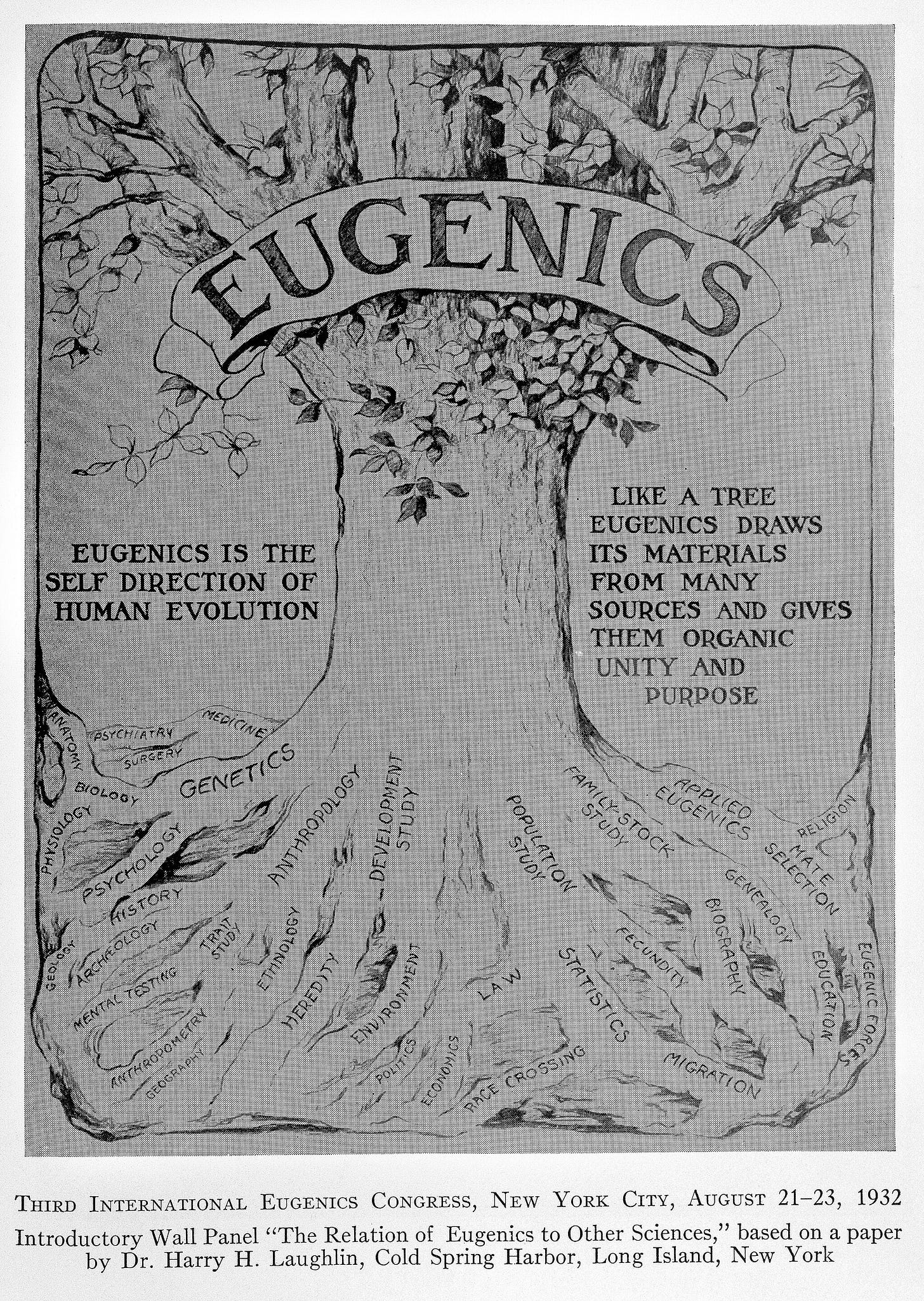Legacies of Eugenics in Science
The rise of eugenics in contemporary US policy has roots in the history of science--a history that we have yet to fully redress.
The Third International Eugenics Congress, held in New York City in 1932, defined eugenics as "the self direction of human evolution." A poster from the public exhibit claimed," Like a tree, eugenics draws its materials from many sources and gives them organic unity and purpose." The poster features a tree, representing eugenics, with visible roots. The roots are labeled with the many fields that contribute to the grand project of eugenics. These include areas of study today such as genetics, biology, psychology, history, anthropology, statistics, education, medicine, and geography. This Exhibit of Eugenics was attended by over 15,000 visitors.
Eugenics is the study of selective breeding to produce an "improved" human race--where improvement is often aligned with whiteness. Historically, eugenics logics have upheld atrocities such as slavery, segregation, forced sterilization, imprisonment, and genocide. Eugenics is close companion to scientific racism--the attempt to legitimize racial discrimination as justified due to biological, genetic, and other "natural" differences. This presumes that race is biological and that some races are less evolved--and thus less human--than others.
While eugenics is roundly rejected by scientists today, this was not always the case. Prior to World War II, eugenics was a mainstream area of study for many areas of science. Titles of scientific journals included Annals of Eugenics, Archive for Racial and Social Biology, Eugenics Quarterly. The Journal of Heredity, which is still in print today, published articles such as "Coeducation and Eugenics" and "Constructive Eugenics." While this journal never took an official position for or against eugenics, they saw it as a valid avenue in the search for knowledge and editors were self-avowed eugenicists. After the horrific conclusions of eugenics logics became clear in the aftermath of the Holocaust, the journal and many eugenicists sought to distance themselves from German schools of thought (despite their previous support). Conversations shifted to discussions of eugenics in plants and ecology, the emergence of population biology, and demography.
What rarely occurred was a reckoning of the legacies of eugenics in subsequent scientific work. While the genealogical descendants of eugenics have forsworn scientific racism and staunchly support the reality that race is a social construct, most fields have not examined how underlying eugenics logics and ongoing bias may remain.
For example, Dr. Emily Klancher Merchant documents how scholarly and popular conversations about population control are the successors of earlier eugenics movements. Her book, Building the Population Bomb, reveals how covert scientific racism remains, as evidenced in how practices and rhetorics of population control focus on the Global South, with predominantly white groups expressing concern about the reproductive proclivities of people of color.
Research on disparities is another example of how researchers reinforce the logics of racial hierarchy. Often when social scientists have sought to understand racial disparities in areas such as health or education, they work from the logics that those who do best (white people) are behaving correctly. Thus, those who are falling behind (Black people, people of color) must be doing something wrong. This unquestioning centering of whiteness as rightness is an example of the ongoing impact of eugenics logics, as well as other systems of racial dominance.
We must deal with the unaddressed legacies and logics of eugenics. We have failed to engage in a full reckoning of how scientific racism remains embedded in the stories of science. As a consequence, it is that much easier for these racist norms to resurface.
This is precisely what is occurring in the United States government and elsewhere. We are seeing a widespread adoption of eugenics logics. Evidence of this trend is liberally sprinkled throughout executive priorities. Anti-DEI sentiments refute the impacts of race-based systemic harms and instead imply that racial disparities are a "natural" outcome. The implications of calling someone a "DEI hire" is that they could not have been the most qualified candidate. This is eugenics logic. Other examples: the erasure of the contributions of people of color to our nation's accomplishments, withdrawing life-sustaining aid support from countries in the Global South, centering white people in concerns about birth rate decline, the indiscriminate deportation of men, women, and children of color with no regard for their well-being or their legal status while simultaneously opening the doors to white Afrikaner refugees while closing the border to virtually all refugees of color.
This is not to say that science is to blame for these atrocities. Rather, it represents an opportunity to engage in a reckoning with the past that roots out eugenics logics, thus strengthening our ability to combat the challenges of the current moment.



